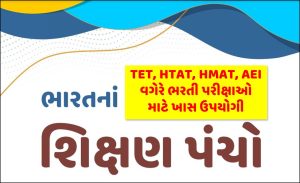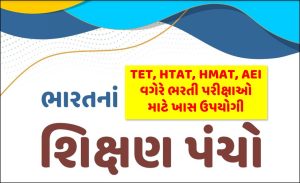Bharat Na shikshan Pancho Education is a powerful and pervasive agent of change. Indeed education holds the key to social change and national development. The education system which India inherited at the time of independence had hardly any relevance to the requirements of the living conditions prevailing in the country at that time. After independence India entered a new phase of national life.
Bharat Na shikshan Pancho
The Central and State Governments are fully conscious of their educational responsibilities and numerous commissions and committees have been constituted to suggest suitable schemes for reforming the entire educational system. Three important education commissions formed in independent India are: 1. University Education Commission (1948-49) 2. Secondary Education Commission (1952-53) 3. Indian Education Commission (1964-66).
1. UNIVERSITY EDUCATION COMMISSION: 1948-49 (Radhakrishnan Commission) University Education Commission (1948-49) is the first Education Commission in the independent India. Government of India appointed the Commission in November 1948 to report on Indian university education and suggest improvements for future requirements of the country. Dr .S. Radhakrishnan, who later became the President of India, was the chairman of the commission and hence it was also called by the name Radhakrishnan Commission.
Bharat Na shikshan Pancho
2. SECONDARY EDUCATION COMMISSION: 1952-53 (Mudaliar Commission) In order to review the present position of secondary education in India and to suggest measures for its overall improvement, Government of India appointed a Secondary Education Commission on September 23,1952. Dr. A. Laxmanswamy Mudaliar, Vice-chancellor of the University of Madras, was the Chairman of the committee, and hence it came to known by the name Mudaliar Commission. A.N.Basu was the secretary of the commission with seven other members. The commission submitted its 240 pages report on August 29, 1953.

3. INDIAN EDUCATION COMMISSION: 1964-66 (Kothari Commission) Indian Education Commission (1964-66), popularly known as Kothari Commission, was the third education commission constituted in the independent India. The commission was set up on 14th July, 1964 under the Chairmanship of Dr. D.S.Kothari, the then Chairman of the University Grants Commission, with J.P.Naik as its Secretary.
The purpose of the commission was to advice the Government on national pattern of education and on the general principles and policies for the development of education at all stages and in all aspects. The commission studied the problems of Indian education in detail and at length and submitted its valuable report on 29th June, 1966. The report of the commission opens with the sentence, ‘the destiny of India is now being shaped in her classrooms’.
Bharat Na shikshan Pancho
4. NATIONAL POLICY ON EDUCATION (1986) National Policy on Education – 1986 (NPE-1986) is the plan of action chosen by the Government of India on educational matters in the country. After a nation-wide debate and thorough discussion at different levels, the Policy got approval of the parliament in May, 1986. A Programme of Action (POA) was also chalked out for the implementation of the National Policy on Education. The NPE-1986 has suggested comprehensive reforms in education from pre-primary to university stage.
5. REVISED NATIONAL POLICY ON EDUCATION (1992) The recommendations of the National Policy on Education were implemented in 1986 itself. After four years of its recommendations, the effectiveness was reviewed by Rammurti Committee in 1990, and later on the recommendations were revised by Janardan Reddy Committee in 1992. Taking the suggestions of these two committees into account, the National Policy on Education was slightly modified in 1992.
Bharat Na shikshan Pancho
NATIONAL CURRICULUM FRAMEWORK-2005 The National Curriculum Framework-2005 (NCF-2005) is a country wide agenda for activated school education formulated by NCERT in 2005. Its purpose is to evolve a national system of education capable of responding to India’s diversity of geographical and cultural milieus while ensuring a common core of values along with academic components. It is a means of modernizing the system of education.
ભારતના શિક્ષણ પંચો ગુજરાતી PDF ડાઉનલોડ કરો અહીંથી
